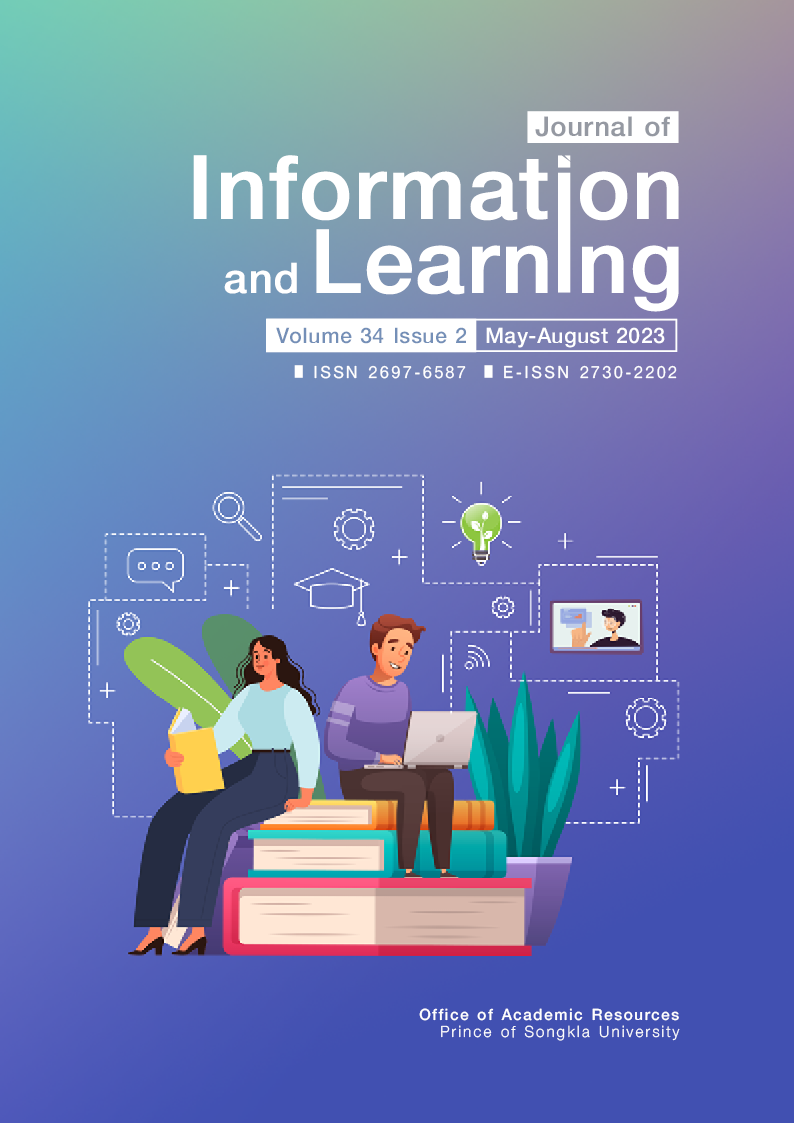The Information Behavior of Researchers on the Culture of the Greater Mekong Subregion
Main Article Content
Abstract
The purpose of this paper was to present the results of an empirical investigation into the information behavior of researchers focusing on cultural issues in the Greater Mekong Subregion (GMS). The ultimate goal is to establish a solid foundation for the development of a semantic search system. To accomplish this objective, Wilson’s information behavior theory, which comprises three elements: defining information needs, seeking information, and the utilization of knowledge, was employed. A qualitative research method was adopted for data collection, which involved conducting interviews with 23 key informants. The results showed that researchers’ purpose of using information was divided into three categories: education, work, and personal interests. In regards to browsing behavior and accessing information, it was found that most of the informants used web search engines to access general information, followed by databases of academic and research institutes to obtain information for research or reference. When personal information resources were necessary, archives or specific locations were employed. The information used most frequently by key informants and considered valuable for searching was categorized into tradition name, location, content classification, abstract, and ethnic group. This study’ outcomes provide insights into the behavior of information needs and cultural accessibility of the Mekong countries among researchers as well as the browsing behavior issues and obstacles encountered by the users. The findings and recommendations can be used as a basis for developing a semantic search system that meets the needs of researchers.
Article Details

This work is licensed under a Creative Commons Attribution-NonCommercial-NoDerivatives 4.0 International License.
The Journal of Information and Learning is operated by the Office of Academic Resources, Prince of Songkla University. All articles published in the journal are protected by Thailand copyright law. This copyright covers the exclusive rights to share, reproduce and distribute the article, including in electronic forms, reprints, translations, photographic reproductions, or similar. Authors own copyrights in the works they have created as well as the Office of Academic Resources. The Journal reserves the right to edit the language of papers accepted for publication for clarity and correctness, as well as to make formal changes to ensure compliance with the journal's guidelines. All authors must take public responsibility for the content of their paper.
References
Abras, C., Maloney-Krichmar, D., Preece, J. (2004). User-centered design. In W. Bainbridge, Encyclopedia of human-computer interaction. Sage publications.
Bawden, D., & Robinson, L. (2011). Chapter 6 individual differences in information-related behaviour: What do we know about information styles? A. Spink & J. Heinström (Eds.), New directions in information behav-iour (library and information science, vol. 1), Emerald group Publishing Limited. https://doi.org/10.1108/S1876-0562(2011)002011a009
Burnett, G., & Jaeger, P. T. (2011). Chapter 7 the theory of information worlds and information behaviour. In A. Spink, & J. Heinström (Eds.) New directions in information behaviour (Library and information science, Vol. 1) (pp. 161-180). Emerald Group Publishing Limited. https://doi.org/10.1108/S1876-0562(2011)002011a010
Catalano, A. (2013). Patterns of graduate students' information seeking behavior: a meta-synthesis of the literature. Journal of documentation, 69(2), 243-274. https://doi.org/10.1108/00220411311300066
Čopič, V., & Dragićević Šešić, M. (2018). Challenges of public-civic partnership in Cambodia’s cultural poli-cy development. Encatc Journal of Cultural Management & Policy, 8(1), 4-15. https://www.encatc.org/media/4531-encatc_journal_vol8_issue1_copic_dragicevic_sesic.pdf
Courtright, C. (2007). Context in information behaviour research. Annual Review of Information Science and Technology, 41, 273-306. https://doi.org/10.1002/aris.2007.1440410113
Department of International Cooperation. (2018). The 21st meeting of the joint commission on Thai-Lao co-operation. http://tica.thaigov.net/main/th/news/1487/62303-(JC).html
Foulonneau, M., & Riley, J. (2008). Metadata for digital resources: Implementation, systems design and interoperability. Chandos.
Gomez-Perez, A. (1995). Criteria to verify knowledge sharing technology. Knowledge Systems Laboratory.
Greater Mekong Subregion Secretariat. (2020, November 5). About the Greater Mekong Subregion. Greater Mekong Subregion. https://greatermekong.org/about
Hjørland, B. (2008). What is knowledge organization (KO)? Knowledge Organization, 35(2/3), 86-101. http://dx.doi.org/10.5771/0943-7444-2008-2-3-86
Khambunruang, C. (2003). Cultural roles of local daily newspapers in Chiang Mai. Chiang Mai News.
Kuhlthau, C. (1991). Inside the search process: Information seeking from the user’s perspective. Journal of the American Society for Information Science, 42(5), 361-371. https://doi.org/10.1002/(SICI)1097-4571(199106)42:5<361::AID-ASI6>3.0.CO;2-%23
McLean, S. (2015). Business communication for success. LIBRARIES. https://open.lib.umn.edu/businesscommunication/chapter/18-3-common-cultural-characteristics/
Ministry of Culture. (2018). Cultural information center. Ministry of Culture. https://digital.m-culture.go.th/
Noy, N. F., & McGuinness, D. L. (2001). Ontology development 101: A guide to creating your first ontology. Stanford University. http://www.ksl.stanford.edu/people/dlm/papers/ontology101/ontology101-noy-mcguinness.html
Paisley, W. J. (1968). Information needs and uses. Annual Review of Information Science and Technology, 3, 1-30.
Prasertsuk, K., Boriphat, P., Nimmanorawong, P., Latsuan, S., & Sukhimok, K. (2016). ASEAN shared cul-ture on the road to intangible cultural world heritage. ASEAN Eye-catching brochure, 5(3), 26-29.
Sithirath, R., Phomphadith, S., Savatvong, K., & Poumvixai, J. (2007). Application of ICT for promoting sustainable development in world heritage sites: Case of Luang Prabang, Lao PDR. Proceedings of Interna-tional Conference on Information and Communication Technology, Vientiane Lao PDR. http://www.ap.ide.titech.ac.jp/publications/Archive/JICT2007Rasmy.pdf
Spink, A., & Park, M. (2005). Information and non information multitasking interplay. Journal of Documenta-tion, 61(4), 548-554. https://doi.org/10.1108/00220410510607516
Sumetharat, S. (1992). Surin local history. Faculty of Humanities and Social Sciences: Surin Rajabhat Uni-versity.
Tantayakul, C. (2017). Movement in the 3rd meeting between the Ministers of Foreign Affairs of the Lancang-Mekong River Cooperation Project. Vijaichina.com. http://www.vijaichina.com/articles/818
Toemchoem, A. (2003). Thai arts and crafts center [Master's thesis, Silpakorn University]. https://doi.org/10.14457/SU.the.2003.192
Umasangtongkul, S. (2005). Information retrieval behavior and bibliographic results evaluation, documents derived from searching of users. Information Technology Journal, 1(2), 51-58. https://ph01.tci-thaijo.org/index.php/IT_Journal/article/view/74114
UNESCO. (2008). Cultural heritage. http://portal.unesco.org/culture/en/ev.php-URL_ID=2185&URL_DO=DO_TOPIC&URL_SECTION=201.html
Uschold, M., & King, M. (1995). Towards a methodology for building ontologies. CiteSeerx. http://citeseerx.ist.psu.edu/viewdoc/download?doi=10.1.1.697.8733&rep=rep1&type=pdf
Wilson, T. D. (1997). Information Behaviour: An interdisciplinary perspective. Information Processing and Management, 33(4), 551-572. https://doi.org/10.1016/S0306-4573(97)00028-9
Wilson, T. D. (2000). Human information behavior. Information Science Research, 3(2), 49-56. https://doi.org/10.28945/576


